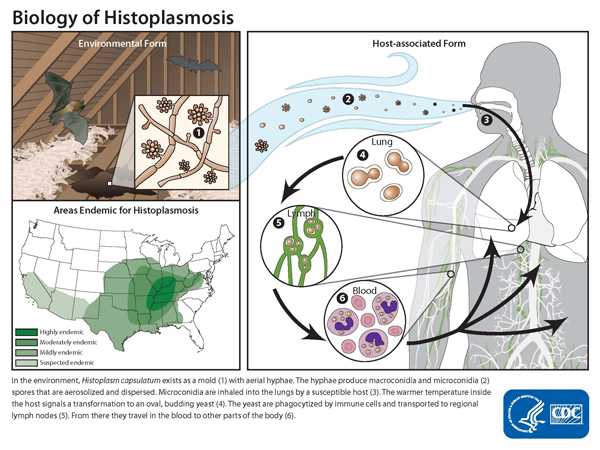Sources of Histoplasmosis
Where does Histoplasma live?

Histoplasma, the fungus that causes histoplasmosis, lives throughout the world, but it’s most common in North America and Central America. In the United States, Histoplasma mainly lives in soil in the central and eastern states, particularly areas around the Ohio and Mississippi River Valleys,1 but it can likely live in other parts of the U.S. as well.2 The fungus also lives in parts of Central and South America,3 Africa,4 Asia,5 and Australia.6
Histoplasma grows best in soil that contains bird or bat droppings. Bats can get histoplasmosis and spread the fungus in their droppings.7
This map shows the approximate areas (called “endemic areas”) where Histoplasma is known to live or is suspected to live in the U.S. Much of what’s known about where the fungus lives in the U.S. is based on studies performed in the late 1940s and early 1950s.1
Life cycle of Histoplasma
Histoplasma spores circulate in the air after contaminated soil is disturbed. The spores are too small to see without a microscope. When people breathe in the spores, they are at risk for developing histoplasmosis. After the spores enter the lungs, the person’s body temperature allows the spores to transform into yeast. The yeast can then travel to lymph nodes and can spread to other parts of the body through the bloodstream.
Click here for the PDF version of image for printing [PDF – 1 page].

I’m worried that Histoplasma is in the soil or in bird/bat droppings near my home. Can someone test the environment to find out if the fungus is there?
No, in this situation, testing the environment for Histoplasma isn’t likely to be useful because the fungus is thought to be common in the environment in certain areas. A soil sample that tests positive for Histoplasma doesn’t necessarily mean that it’s a source of infection, and a sample that tests negative doesn’t necessarily mean that the fungus isn’t there. Also, there are no commercially-available tests to detect Histoplasma in the environment. Testing environmental samples for Histoplasma is currently only done for scientific research. If there are bird or bat droppings near your home, you should have it cleaned up, if possible. If it’s not possible to clean up, try not to disturb it.
References
- Manos NE, Ferebee SH, Kerschbaum WF. Geographic variation in the prevalence of histoplasmin sensitivity. Dis Chest. 1956 Jun;29(6):649-68.
- CDC. Histoplasmosis in a state where it is not known to be endemic–Montana, 2012-2013. MMWR. 2013 Oct 25;62(42):834-7.
- Colombo AL, Tobon A, Restrepo A, Queiroz-Telles F, Nucci M. Epidemiology of endemic systemic fungal infections in Latin America. Med Mycol. 2011 Nov;49(8):785-98.
- Loulergue P, Bastides F, Baudouin V, Chandenier J, Mariani-Kurkdjian P, Dupont B, et al. Literature review and case histories of Histoplasma capsulatum var. duboisii infections in HIV-infected patients. Emerg Infect Dis. 2007 Nov;13(11):1647-52.
- Chakrabarti A, Slavin MA. Endemic fungal infections in the Asia-Pacific region. Med Mycol. 2011 May;49(4):337-44.
- McLeod DS, Mortimer RH, Perry-Keene DA, Allworth A, Woods ML, Perry-Keene J, et al. Histoplasmosis in Australia: report of 16 cases and literature review. Medicine. 2011 Jan;90(1):61-8.
- DiSalvo A. The role of bats in the ecology of Histoplasma capsulatum. In: Ajello L CE, Furcolow ML, editors. Histoplasmosis: proceedings of the second national conference; 1971; Springfield, IL; 1971. p. 149–61.
- Page last reviewed: November 21, 2015
- Page last updated: November 21, 2015
- Content source:


 ShareCompartir
ShareCompartir